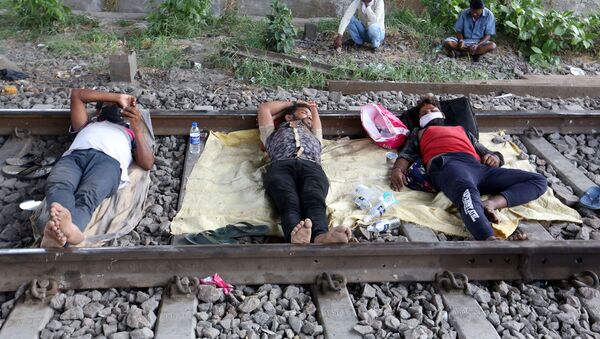An unpaved road leads to narrow by-lanes with sewage water running along in the drains, congested houses and a strong stench in the air; this is any slum area in urban India. Living in such unsanitary conditions makes the nation's 64 million urban slum-dwellers vulnerable to many diseases, and coronavirus is no exception.
We have been seeing the news but we haven't been provided with masks or sanitisers, residents at Seelampur slum say as they worry about the spread of #COVIDー19 pic.twitter.com/9TIt7ijj3G
— Aakriti Sharma (@_aakritisharma) April 9, 2020
The first positive COVID-19 case from a slum area in India was reported in Dharavi in Mumbai, which soon sent the officials into a tizzy because they feared the spread of the virus in congested areas would be difficult to control. As many as 10 people have tested positive in the slum since the 56-year-old man died on 1 April.
With no home quarantine option available for infected people, authorities in Mumbai have already pushed their cluster contamination plan into action by turning sports stadiums into temporary quarantine facilities for mild and suspected cases of COVID-19.
The NSCI Dome being transformed into a huge quarantine centre as we step up our contact tracing and testing in @mybmcWardGS . Till now, our contact tracing has been highest and testing too. Ensuring that carriers are isolated for their own safety and for that of others pic.twitter.com/tjv5e3eKqV
— Aaditya Thackeray (@AUThackeray) April 8, 2020
The Cluster Containment Strategy of the Government of India states “it would be to contain the disease within a defined geographic area (through the) early detection of cases, breaking the chain of transmission and thus preventing its spread to new areas. This would include a geographic quarantine, social distancing measures, enhanced active surveillance, testing all suspected cases, isolation of cases, quarantine of contacts and risk communication to create awareness among the public on preventive public health measures”.
However, in the meantime, a slum in India’s national capital region reported that around 200 people were suspected of having the virus on Tuesday. Positive cases had been reported from the area a few days ago, and As part of the government's preventive measures, the authorities put them into quarantine.
Devastating news coming from Noida- industrial city close to Delhi. Around 200 people of sector 8 slum, suspected to have infected with #coronavirus, are being taken to quarantine centre. pic.twitter.com/GPXTqnXDZy
— Rishikesh Kumar (@rishhikesh) April 7, 2020
Mohammed Nasir, a concerned resident in Delhi’s Seelampur slum area, told Sputnik that people are aware about the prevailing circumstances but there hasn’t been any awareness-raising activity conducted in response to it, and they fear the virus like people throughout the country.
“From past 14-15 days they have barricaded the roads and areas but nobody has come here. We are watching on television about the disease and its spread but we have not been provided sanitisers or masks or relevant information,” says Nasir.
However, the government’s containment plan states: “Awareness will be created among the community through the distribution of pamphlets, mass SMS and social media.."
While Delhi itself faces a water shortage, its supply in the slum area remains extremely limited, making hand-washing impossible for the residents, says Nasir, adding that social distancing remains a distant dream when seven to eight people are jam-packed in a house of size of a room.
People mostly stay outdoors as there isn't enough space for everyone inside the houses. It is difficult for 6-7 people to remain crammed inside a room all day, says another resident at Seelampur slum area. pic.twitter.com/Y7SBI78L2h
— Aakriti Sharma (@_aakritisharma) April 9, 2020
"What else can we do but stay outside? It is difficult for so many people to remain crammed inside a small room all day long," says Savitri, who has three kids and lives with her husband, his parents and brother.
India has recorded around 6,000 positive cases of COVID-19; 166 have died of the disease.The authorities have been trying to tighten the screws to prevent the further transmission of the virus.
A virologist at Amity University, Dr Narayan Rishi, has suggested that under the current circumstances where there is no vaccine or treatment for COVID-19; there is no other way to contain the virus in slum areas except by promoting social distancing.
He says: “It is up to the health ministry but the best way is to make quarantine facilities where social distancing can be practised. But considering the population in the slum area, it is a difficult task to put this into action. Also, there is no preventive drug which can be suggested in the present scenario, which is also part of the problem. In this difficult time, the only possible way is to take them out to a distant place.”


